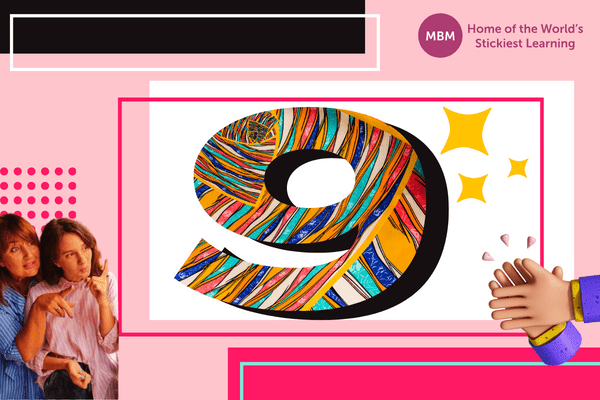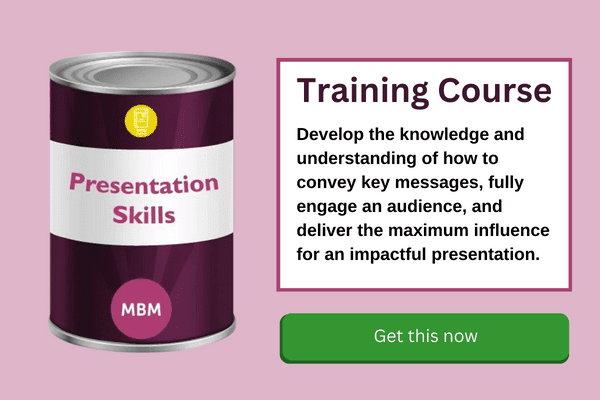Get From Instantly Forgettable to Wonderfully Memorable Presentations
Memorable presentation aren’t hard We just need to re-tune the way we prepare.
First, a story before getting into crafting memorable presentations. During our Category Management skills training course, we ask each Learner to have prepared a category plan pitch. The brief is that it must not use slides, is less than 7 minutes and they’ll be scored on their engagement and influencing.
Each Learner presents and gets some feedback from the group. Then, after everyone has presented we break for lunch. After lunch, the Learners are asked to draw a table on a blank piece of paper showing each learner’s name, their category, the key message and the value.
Unsurprisingly few can complete the key message column and no one can complete the value column for anyone. At this point we ask them to imagine the buyer, the MD, or the customer, and that this might be their third presentation of their day so far. And with ease, ‘If no one here can remember your presentation an hour or two ago, and certainly not the key message or the value, what hope have we of that person being driven to action from our presentation?’. The Learners knew the answer to that question. We have become instantly forgettable. Rather, we must aim to give memorable presentations.

Why has Our Presentation Become Instantly Forgettable?
Well, there are 2 reasons:
#1- People Are Busy
They might see 5 presentations in a day. We move from email to meetings to telephone conversations to WhatsApp messages to voicemails to…You get the idea. We might be focused when being presented but after that, it’s back to a million things trying to grab our attention. And to ‘survive’ we have to forget some things because we can’t retain it all and only the memorable remains. Specifically, the stuff that made us laugh, or solved a problem or where we engaged with people like ourselves or was dam interesting. The boring has to be dumped and it gets dumped fast.
#2- We Aren’t Used to Thinking About the How in Presentations, Only the What
In preparing for presentations we spend all our efforts on data analysis, building ‘great’ slides and saying a lot of words in the presentation. Not on the delivery itself. We just don’t think about how we are going to engage the audience. It doesn’t cross our minds. We are focused on the what – the content of what we are presenting and what we’ll say, but not how.
It’s a bit like comparing two comedians. The first stands on the stage and tells us jokes. One after another. She hopes that the jokes are enough to make us laugh. The second comedian also tells us great jokes but he also uses pauses to wait for us to stop laughing, uses his body to make gestures to complement the joke, and asks questions of the audience. Both have the same material. The second comedian has thought about the how as well as the what.
We need to think about the how as well as the what if we are to deliver memorable presentations.
Let’s find out 9 tips on how we can move from being Instantly Forgettable to being Wonderfully Memorable and creating memorable presentations…
Sticky Learning ® is 7 times more effective than 1-day training courses. Plus, you will get a Chain of Evidence proving your Return on Investment. Discover soft skills training that changes behaviours long term.

9 Tips to Create Memorable Presentations

Tip#1: The 2 Most Important Parts of Your Presentation
The open and the close.
This is when people are most ‘awake’. At the start, they are subconsciously assessing whether this is going to be boring. Remember first impressions matter and they do when we present and certainly when we start.
Start with a question, insight or a headline:
- ‘How many people here also have a dog? <Shows picture of a dog>
- The surface in the house that transfers the most common colds in a family is the fridge.
- Last week we lost £9.1m through shortages.
Make your opening memorable. Close the same way. What do you want them to feel when you begin? And how do you want them to feel when you close? Intrigued? Engaged? Surprised? illuminated? Choose.
Tip#2: M o n o t o n e Kills Interest
Here’s our second tip for giving Memorable Presentations. Ever sat in the audience of a presentation and the guy was just waffling on? It might be very interesting but there are no pauses, no engagement, no change in pace, or volume. Just monotone.
In the film ‘The Hunger Games’ there is a scene when Woody Harrelson, who plays Haymitch Abernathy – the mentor, says to Katniss and Peeta, “I promise you, he’s (President Snow) not happy. Instead of being in love, you two sound like you’re reciting from a drilling manual.” Their words are of being in love, yet it is delivered with such a lack of feeling that it is not believable.
So we need to change our objective from sharing information to engaging the audience. The former is about sharing the volume of words. The latter is about the audience engaging with our words. From a volume objective to an engagement objective. Changing our objective means that we then become mindful of using:
- Pace: Changing our pace to improve our engagement. Slow for some complex information and faster for other parts.
- Volume: Raising and lowering our volume to improve engagement, which moves away from the monotony.

Tip#3: No Slides
Slides are boring. They’re lazy and most people use them to lean on, rather than to illuminate. This article called, ‘Do Not Start with Powerpoint – 7 Pieces of Preparation‘ also includes a free template to help you prepare for a presentation.
Tip#4: PAUSE
This article on Medium is well worth reading because it talks about the ‘Power of Pauses’. Yes, they’re talking about public speaking but presenting is a form of public speaking. They are both about engaging an audience, be they 100’s or just presenting to one. Alf Rein talks about 5 different pauses:
- The pause for emphasis. The pause for a punchline.
- The pause for reflection.
- The dramatic pause.
- The lead-in pause.
- The break.
…And some great advice, like this:

Tip#5: Aristotle’s Advice
I’m going to tell you about the great Aristotle and his advice on how to tell people to keep them engaged.
He was famous for his advice on making it stick, as we would call it. He said, ‘Tell them what you are going to tell them, tell them and then tell them what you have told them.
His advice was about 3 parts of engaging the audience to create memorable presentations.
See what I did there!
Tip#6: Be More Tree
For some presentations, you need to stand. Stand in front of only a few people but stand you must and stand well. Like a tree rooted to the ground. Not rocking back and forth on your heels to toes or on the sides of your feet. Allow the ground to ground you. Feel the roots rise within you. With this brings confidence and with confidence comes engagement. Not arrogance, but confidence.
Tip#7: We’ve Been Telling Stories for an Eternity and Yet We Stop at Work. Don’t Stop. Start.
‘Don’t run’. This was my Dad telling his 7-year-old son not to, as we unloaded the weekly food shop from the car to the house. I was keen to help, as any little boy helping his Dad. I stood at the boot of the car keen to take the next thing into the house. Dad handed me a 1-litre glass jar of orange juice (I think I may have single-handedly been responsible for the move to cartons!). Roll forward 20 seconds and there I am, sprawled out on the concrete path crying, blood everywhere. I had ran. My Dad spent the majority of the 6 hours we waited at A&E telling me that he had specifically told me not to run. So, why did I? The answer is in the meaning we give to the words we hear.
This is a story I use in our article, ‘The Meaning We Give to the Words We Hear‘ because it highlights the point so well about how the words we use, matter.
I understand that stories are ‘not something you do’, but wait…If I asked you to tell me about a time when you had an accident, you’d come alive telling me that story. ‘I was in the playground and tried to catch a ball when I tripped over this really big dog and crack went my arm and…’ There would be animated body language and humour, and a tale would be told.
Getting from there, a story at home, to a story at work will take some effort but it is very possible. Begin by thinking about having a start, a middle and an end.
Tip#8: Break the Rules to Create Memorable Presentations
No one said that you had to stand at the front, with them around a table, and then talk at them. Yes, it has become the norm. Break the norm. Here are a few ideas:
-
- Use foam boards. A2 or A3 and show those, and then hand them around for them to hold them. Each one has a graph, facts or just an image. It’s just a prop to support what you are saying.
- Put blank pieces of flipchart paper on the walls and ask them to gather around in a semi-circle as you write on the flip charts your pitch/information/share.
- Bring only high-resolution images on slides. Nothing to read. The images complement your words. You are the presentation, supported by some images. Not the other way around.
Tip#9: They Will Be Whatever You Are Being
If you are bored, they will be bored.
If you are nervous, they will be nervous for you.
And if you are disengaged with them because you are reading the slides or your notes, they will be disengaged with you.
Equally…
If you are passionate about what you are passionate about, they’ll likely be passionate too.
If you are confident, they’ll be confident with you.
And if you use humour, they’ll likely laugh along.

Summary of Giving Memorable Presentations
There you have it. Transform presentations from forgettable to memorable with tips like impactful openings, engaging delivery, avoiding slides, leveraging the power of pauses, following Aristotle’s advice, adopting a confident stance, embracing storytelling, breaking presentation norms, and aligning your energy with the audience. Remember, it’s not about what’s on the slides, but how you deliver. After all, a presentation is nothing without the presenter. That’s you!
Make sure to engage with us on Instagram.


